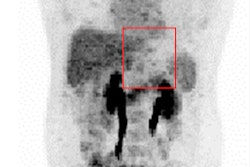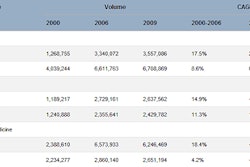SAN FRANCISCO - FDG-PET and PET/CT are critical imaging modalities in diagnosing and managing patients with gastrointestinal cancer, as demonstrated in several lines of research presented at this week's American Society of Clinical Oncology (ASCO) Gastrointestinal Cancers Symposium.
Whether PET is used in combination with biomarkers or specific genetic profiles, or in its more traditional role in detecting metastases and primary tumors, research presented at the meeting continues to highlight the modality's versatility. Three poster presentations from the meeting, summarized below, highlight the role of FDG-PET and PET/CT as key research tools.
Esophageal adenocarcinoma
Esophageal adenocarcinoma (EAC) is the fastest growing cancer in Australia, but surgery, the standard approach to care, does not significantly improve outcomes. Neoadjuvant chemotherapy, with or without radiotherapy, has produced only modest gains.
Researchers from the University of Queensland and Queensland Institute of Medical Research, in cooperation with other Australian centers, are looking for genetic components to help predict which patients will respond to chemotherapy. The hope is that this could help physicians better select candidates and therapeutic agents for EAC.
The researchers presented preliminary data from the DOCTOR trial, a randomized, phase II study of preoperative cisplatin, fluorouracil, and docetaxel with or without radiotherapy based on poor early response to standard chemotherapy for resectable EAC. They offered gene expression data for 22 patients with early FDG-PET response.
Nicola Wayte, PhD, and colleagues analyzed samples of histologically proven invasive EAC and clinical stage T2/3 tumors. All patients received chemotherapy with cisplatin (day 1) and fluorouracil (days 1-4). Early metabolic response was defined as a reduction of more than 35% in maximum standardized uptake value (SUVmax) by day 14 at FDG-PET compared with the baseline scan. The group obtained whole-genome messenger RNA expression for pretreatment biopsies using HumanHT-12v4 expression chips.
Eight patients showed early response to chemotherapy on PET, versus 14 nonresponders. The next step was to identify differentially expressed genes among PET responders and nonresponders.
The study has identified 57 genes as significantly differentially expressed between the two classes of patients (p ≤ 0.001). In addition, a global test indicated significantly different expression profiles between the classes (p = 0.031), and using a gene classifier to predict PET response. Epigenetic and apoptotic processes were significantly overrepresented in the gene list based on a gene ontology analysis.
"The basis for this study is to show that there's a biological reason for the response we've seen on PET, and that it's not just a phenomenon we're seeing for no particular reason, so that's encouraging," said Wayte in an interview with AuntMinnie.com. "Can we skip the PET response? I don't think it's reliable enough to say, 'OK, those who don't respond on PET need more aggressive treatment,' but I think [the study's approach] is a good way to go," she said.
Eventually, the idea is to "come up with a very short list of genes that we can then interrogate using not necessarily a microarray approach but more basic lab approaches," which would be cheaper as well as easier to perform, she said.
"If we're able to say the response correlated with a protein, then I think that can be explored a lot more readily and cheaply in pathology labs all over the world," she said. "The facilities are already in place. The idea is to come up with a genetic panel and say you're likely to respond to therapy -- or, if not, what your chances are."
If the patient's risk is very high and he or she is seen as unlikely to respond, then going straight to surgery might be a better option, or perhaps higher doses or different chemotherapy agents will improve the response in these patients, she added.
The preliminary results do support a biological basis for the association between early metabolic PET response to preoperative therapy and survival in esophageal adenocarcinoma patients. The list of differentially expressed genes may include potential biomarkers of treatment response that will require additional research after the phase II clinical trial, Wayte said.
Genetics is just emerging as a factor in gastric cancer outcomes because, unlike in breast cancer or colorectal cancers, the ability to tie specific genetic profiles to therapeutic response was unknown until recently, and researchers are eager to explore it now despite difficult barriers such as cost, she said.
"I think one of the big problems with these studies -- although they're really exciting -- is that they're still quite expensive to do," Wayte said. "The microarray tests use thousands and thousands of genes, and beyond the costs, the facilities for running these are still in the arena of research-based labs, so we're not quite ready to move it into translation."
As for predictions on the present study, "I'd imagine that the list of genes is going to change before the trial ends, and both the cutoffs and the strength of the test will be a lot better," Wayte said.
PET/CT for stromal tumors
In another study from the ASCO symposium, Dr. Kozo Yoshikawa, PhD, and colleagues from the University of Tokushima in Japan found that PET/CT can predict the malignant potential of gastrointestinal stromal tumors (GISTs) better than the standard size criterion alone, identifying patients who need additional tests.
The risk of malignancy of gastrointestinal stromal tumors is usually determined by tumor size and mitotic count, the authors explained in their poster. However, due to technical complexity and tumor heterogeneity in biopsy, accurate preoperative evaluation of the malignant potential of GISTs is very difficult to attain.
Yoshikawa and colleagues sought to evaluate the utility of preoperative PET/CT and MRI for predicting the malignant potential of GISTs, clarifying the following:
- The relationship between SUVmax and risk category
- The relationship between the apparent diffusion coefficient (ADC) index and risk category
- The relationship between the ADC index and SUVmax
The study examined 10 patients with GISTs who underwent preoperative PET/CT. They were divided into two groups -- low/intermediate risk or high risk -- based on risk category, which was based on tumor size and mitotic index. The researchers examined the relationships between SUVmax values and GIST parameters, and found significant correlation between the mitotic index and SUVmax (p = 0.029), but there was no correlation between SUVmax and tumor size.
The Ki67 labeling index was also significantly higher in the high-risk group (8.63 ± 6.2) than in the low/intermediate-risk group (1.75 ± 0.52), and there was a significant correlation between the Ki67 labeling index and SUVmax (p = 0.028). Analysis showed that a mitotic index of 5/50 HPF was equivalent to an SUV of 4.3, and a Ki67 labeling index of 5 was equivalent to an SUVmax of 6.3. An SUVmax of 5 accurately predicts the malignant potential between high- and low/intermediate-risk patients, they said; cases with an SUVmax of 5 or greater might have malignant potential.
FDG-PET accumulation in colon
Results from a third study suggest that PET/CT can find unexpected colonic pathology in gastric cancer patients, though colonoscopy is required to localize the tumors precisely, according to researchers from Seoul St. Mary's Hospital and Catholic University of Korea.
PET/CT's ability to detect synchronous colonic pathology in gastric cancer patients is not fully defined, wrote Dr. Kyo Young Song and colleagues. In their poster presentation at ASCO, they presented their study of 370 patients diagnosed with primary gastric cancer who underwent curative resection. (Those with a history of known colonic malignancy or colon surgery were excluded.)
In all, 147 patients underwent PET/CT and colonoscopy preoperatively. The researchers examined FDG uptake patterns, classifying them as focal (foci of FDG uptake > 3.5 SUVmax, group A) or diffuse (FDG uptake < 3.5 SUVmax without foci, group B).
Among the 18 patients with focal FDG uptake in the colon, six harbored an unexpected colonic adenocarcinoma, the group reported. The mean SUVmax value for group A (focal) was 7.3 ± 2.3, and for the six patients with unexpected adenocarcinoma it was 9.4 ± 2.9 (p = 0.02). In group B, the diffuse uptake group, the most common colonic pathology was tubular adenoma with low-grade dysplasia, followed by a hyperplastic polyp. The only difference was in uptake; no significant differences were found for age, gender, or primary gastric cancer stage between the groups, Song and colleagues reported.
Incidence of high-risk adenoma or adenocarcinoma by patient group
|
||||||||||||||||||||||||||||||||||||||||||||
"The focal uptake pattern in [the] colon on preoperative PET/CT in gastric cancer patients should be followed by colonoscopy evaluation for incidental significant colonic pathology, even colon cancer," they wrote. Based on this study, however, there is no cutoff SUVmax value at which colonoscopy evaluation based on PET/CT should be mandatory.



















